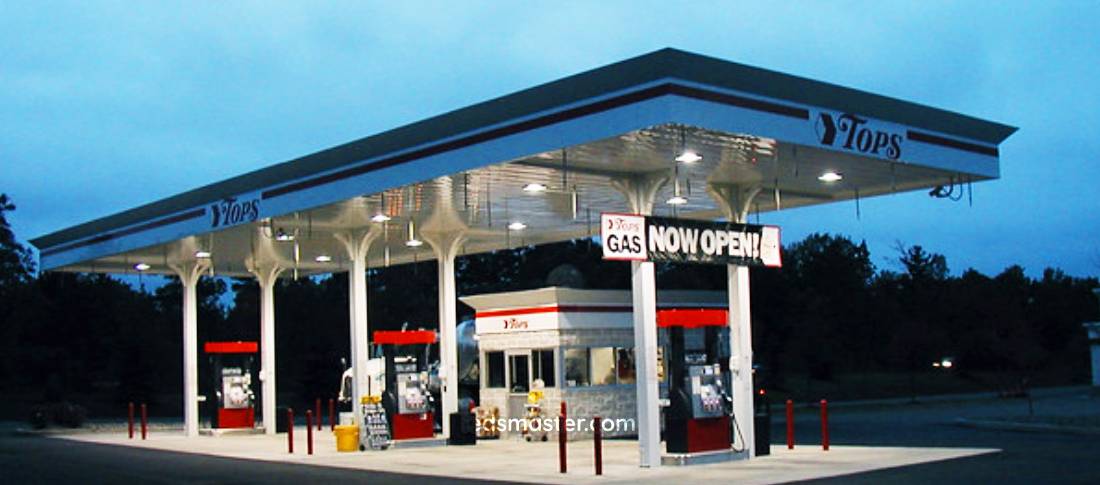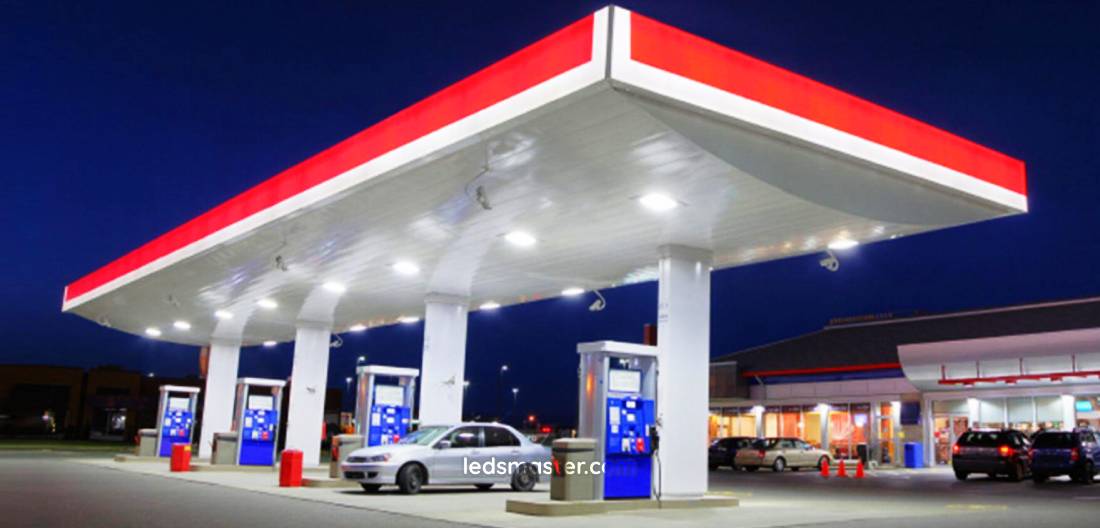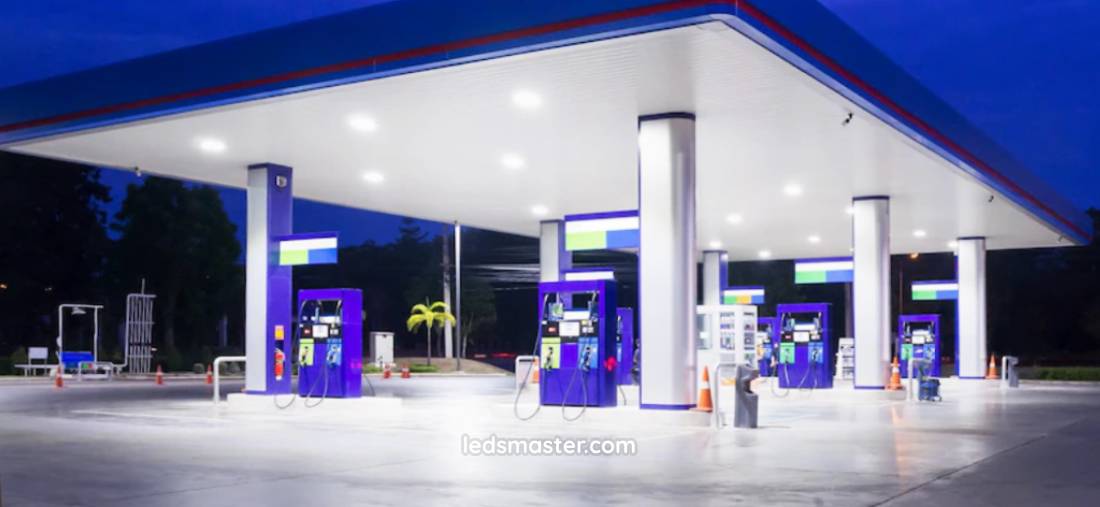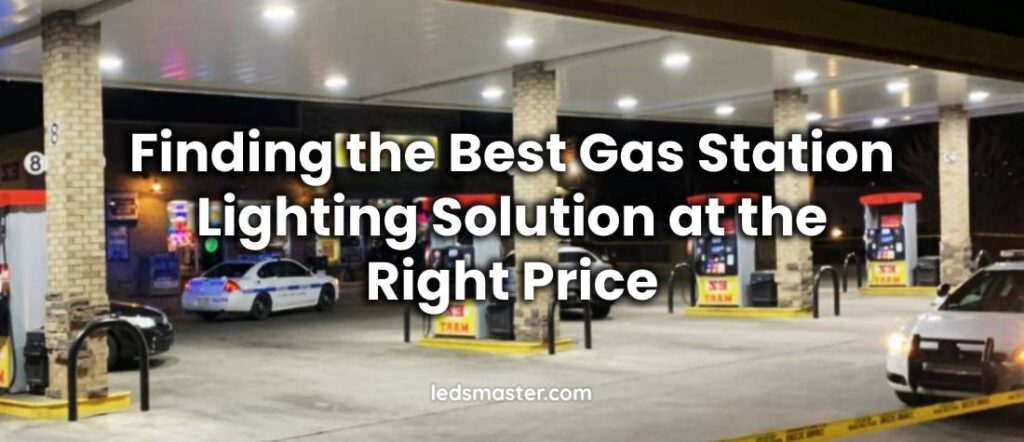Gas station lighting plays a major role in attracting customers, ensuring safety, and maintaining energy efficiency. The cost of installing and maintaining lighting depends on multiple factors, including the type of fixtures used, installation expenses, maintenance requirements, and energy consumption. A well-planned lighting system improves visibility and reduces long-term operational costs.
| Description | Total Cost | Estimated Savings | |
|---|---|---|---|
| LED Lighting for Gas Stations | Cost of installing LED lighting for gas stations, including bulbs and fixtures. | $25,000 – $50,000 (for medium-sized station) | 50-70% reduction in energy costs annually |
| Solar Lighting Solutions | Cost of integrating solar lighting systems for outdoor areas like parking lots and pumps. | $100,000 – $150,000 for full installation | $15,000 – $20,000 in annual savings (depending on location) |
| Traditional Lighting vs. LED | A comparison of the cost difference between traditional lighting (e.g., halogen) and LED lights. | Traditional: $500 per fixture, LED: $200 per fixture | Energy savings: 60% annually |
| Motion Sensor and Smart Lighting | Cost of installing motion sensors and smart controls for energy-efficient lighting management. | $10,000 – $15,000 for full system | 10-20% energy savings annually |
| Utility Rebates and Incentives | Value of utility rebates or incentives available when switching to energy-efficient lighting. | $2,000 – $10,000 (varies by region) | Immediate rebate plus long-term energy savings |
| Maintenance Costs of Lighting Systems | Comparison of annual maintenance costs for traditional, LED, and solar lighting. | Traditional: $5,000/year, LED: $1,500/year, Solar: $2,000/year | Reduced maintenance with LED and Solar lighting |
Table of Contents
ToggleFactors That Influence the Cost of Gas Station Lighting
Types of Lighting Fixtures
The type of lighting fixture used in a gas station significantly affects both the upfront cost and long-term expenses. Traditional lighting solutions such as metal halide and fluorescent fixtures have been widely used in the past, but they come with higher energy consumption and more frequent maintenance needs.
Modern lighting solutions, such as LED technology, offer superior energy efficiency, durability, and reduced maintenance requirements. LEDs provide high-quality illumination while consuming less electricity, making them a cost-effective option over time. While the initial investment for LED fixtures may be higher than traditional lighting, the long-term savings in energy costs and maintenance expenses make them the preferred choice for many gas station owners.
Installation Expenses
The cost of installing gas station lighting depends on multiple factors, including the number of fixtures required, wiring complexity, and any additional infrastructure needed. Installing a new lighting system for a newly constructed gas station typically requires a higher investment compared to retrofitting an existing location with upgraded fixtures.
Labor costs also impact installation expenses. Hiring experienced electricians and lighting specialists ensures a quality installation, reducing the risk of future electrical issues. However, professional installation often comes at a premium, adding to the overall project cost.

Energy Consumption and Efficiency
The energy consumption of a gas station’s lighting system has a direct impact on monthly electricity bills. Traditional lighting fixtures, such as metal halide lamps, consume significantly more energy than modern LED systems.
Gas stations that operate 24/7 require consistent illumination, making energy efficiency a priority. Switching to LED lighting, installing motion sensors, and utilizing dimming technology during off-peak hours can help reduce electricity consumption without compromising visibility or security. Gas station owners who invest in energy-efficient lighting solutions benefit from lower operational expenses over time.
Maintenance and Replacement Costs
Lighting systems require ongoing maintenance to ensure consistent performance. Traditional lighting options, such as metal halide and fluorescent bulbs, tend to have shorter lifespans and may require frequent replacements, leading to higher maintenance costs.
LED fixtures, on the other hand, offer significantly longer lifespans and lower failure rates. With some LED products lasting up to 50,000 hours, the need for replacements is drastically reduced. Additionally, LED lights generate less heat, minimizing wear and tear on fixtures and electrical components.
Regular maintenance, including cleaning fixtures and checking electrical connections, can help prolong the life of any lighting system. A well-maintained system reduces unexpected failures and ensures that the gas station remains well-lit at all times.
Environmental and Regulatory Considerations
Gas stations must comply with local and federal regulations regarding outdoor lighting. Many municipalities enforce restrictions on brightness levels, light pollution, and fixture placement to reduce environmental impact.
Certain locations may require gas stations to install fixtures with shields to minimize glare and prevent excessive light from spilling into residential areas. Compliance with these regulations may increase installation costs, but failure to meet these requirements can result in fines or costly modifications.
Additionally, some governments offer incentives or rebates for businesses that implement energy-efficient lighting solutions. Taking advantage of these programs can help offset initial costs and encourage gas station owners to invest in sustainable lighting options.
Comparing the Costs of Different Lighting Technologies
LED Lighting
LED lighting has become the preferred choice for gas stations due to its energy efficiency, durability, and lower long-term costs. While the upfront cost of LED fixtures may be higher than traditional options, the energy savings and reduced maintenance expenses result in significant cost reductions over time.
LEDs provide consistent brightness, operate at cooler temperatures, and offer better light quality compared to older technologies. Their long lifespan reduces the frequency of replacements, making them a financially smart investment for gas station owners.
Metal Halide Lighting
Metal halide lamps were once widely used for gas station canopy lighting due to their high-intensity output. However, these fixtures consume more electricity and have shorter lifespans than LEDs. The frequent need for bulb replacements and maintenance increases operational expenses, making metal halide lighting less cost-effective in the long run.

Fluorescent Lighting
Fluorescent lighting is sometimes used for canopy lighting and signage. While it provides moderate energy efficiency, the shorter lifespan of fluorescent bulbs leads to higher replacement costs. Additionally, fluorescent lights may not perform well in extreme weather conditions, making them less reliable for outdoor use.
Ways to Reduce Gas Station Lighting Costs
Choosing Energy-Efficient Fixtures
Investing in energy-efficient lighting solutions helps reduce electricity expenses without sacrificing brightness or visibility. LED fixtures are designed to provide high illumination levels while using significantly less power than traditional lighting options.
Utilizing Motion Sensors and Timers
Installing motion sensors and timers ensures that lights operate only when necessary. Motion sensors are particularly useful in less-trafficked areas, such as storage spaces or service bays, where full-time illumination is not required. Timers can be programmed to adjust brightness levels based on peak and off-peak hours, leading to additional energy savings.
Taking Advantage of Incentives and Rebates
Many energy providers and government programs offer financial incentives for businesses that adopt energy-efficient lighting solutions. Researching available rebate programs can help gas station owners lower the upfront cost of upgrading their lighting systems.
Regular Maintenance and Cleaning
Routine maintenance, including cleaning light fixtures and checking for wiring issues, improves efficiency and extends the lifespan of the lighting system. Accumulated dust and debris can reduce brightness levels, making regular cleaning an effective way to maintain optimal illumination.
Retrofitting Instead of Replacing Entire Systems
For gas stations looking to reduce costs, retrofitting existing lighting systems with energy-efficient fixtures is a viable alternative to complete replacement. Retrofitting allows gas station owners to upgrade their lighting without incurring the high costs associated with a full system overhaul.
The Long-Term Impact of Gas Station Lighting Costs
Return on Investment for Energy-Efficient Solutions
Upgrading to energy-efficient lighting can appear costly at the outset, especially when considering the price of LED fixtures and their installation. However, when factoring in the reduced energy consumption and lower maintenance needs of modern lighting solutions, the long-term savings quickly outweigh the initial investment. LED lights, for example, use far less electricity than traditional options, resulting in significantly lower utility bills. Additionally, these systems have a longer lifespan, which means fewer replacements and reduced maintenance costs. Gas station owners who prioritize energy efficiency can benefit from steady savings, with the investment paying off over time as operational costs decrease.
The return on investment (ROI) for energy-efficient lighting solutions can be seen in a few years, depending on the size and energy usage of the station. The savings generated from reduced energy consumption and maintenance can accumulate and provide a strong financial benefit for gas stations over the long term. These lighting solutions also help improve operational performance, as fewer maintenance calls and more reliable lighting contribute to a smoother, more cost-effective operation.
Impact on Customer Experience and Business Revenue

Lighting is more than just a functional aspect of a gas station; it plays a major role in shaping the customer experience. A well-lit gas station creates a welcoming and inviting atmosphere, which is crucial for attracting customers, especially during the night. When customers see a well-lit station, they are more likely to stop for fuel or other services. Poor lighting, on the other hand, can make a station appear unsafe or uninviting, potentially driving away business.
Quality lighting not only helps increase foot traffic but also impacts overall revenue. Well-lit stations can create a positive impression, encouraging customer loyalty and return visits. Additionally, lighting that improves safety can reduce the risk of accidents, ensuring a better customer experience. Gas station owners who invest in reliable and efficient lighting systems improve not just visibility, but also customer satisfaction, which directly translates into business success.
Furthermore, proper lighting significantly enhances security, both for customers and employees. Adequate lighting in parking areas, pump stations, and convenience store entrances helps deter criminal activity. With the enhanced visibility that modern lighting offers, both customers and staff can feel safer, which ultimately contributes to improved customer trust and higher levels of business activity.
Sustainability and Environmental Benefits
Adopting energy-efficient lighting solutions contributes positively to environmental sustainability. LED lights, for example, consume less power and last longer than traditional incandescent or fluorescent bulbs, leading to a reduction in the overall carbon footprint of a gas station. By choosing energy-efficient options, gas stations can reduce energy waste, which is a significant factor in mitigating environmental impact.
In addition to saving on energy costs, many modern lighting fixtures are built with eco-friendly materials, contributing to the overall sustainability of the gas station. These environmentally conscious decisions are becoming increasingly important for customers who value green practices and sustainability. Gas stations that prioritize sustainable practices may see an increase in customer loyalty and a stronger public image, benefiting from the positive reputation that comes with environmentally responsible operations.
Moreover, some gas stations that adopt renewable energy sources, such as solar power, for their lighting can reduce their reliance on the grid. By installing solar-powered lighting solutions, gas stations can generate their own electricity, lowering utility costs while decreasing the impact of their operations on the environment. This shift to renewable energy not only contributes to sustainability but also offers long-term cost benefits by reducing energy dependence.
Common Challenges in Managing Gas Station Lighting Costs
High Initial Investment
One of the primary challenges gas station owners face when upgrading their lighting systems is the initial financial commitment. Energy-efficient lighting solutions, such as LED fixtures, can be more expensive upfront than traditional options. While the long-term savings in energy costs and reduced maintenance make these systems a smart investment, the upfront capital required can be a barrier for some businesses.
However, this challenge can be mitigated by exploring financing options, such as loans or payment plans, as well as taking advantage of government incentives or utility rebates designed to encourage energy-efficient upgrades. These financial programs help offset the initial costs, making the transition to energy-efficient lighting more manageable and accessible for gas station owners.
Balancing Brightness and Energy Consumption
One of the key challenges when implementing a lighting system is balancing the need for adequate illumination with energy consumption. Gas stations require sufficient lighting to ensure safety, visibility, and security, especially in areas like parking lots, pump stations, and convenience store entrances. However, providing too much light can lead to excessive energy use, increasing utility costs.
On the other hand, insufficient lighting could pose safety risks and reduce visibility for customers. Achieving the right balance involves selecting lighting systems with adjustable brightness settings or using dimming capabilities. This ensures that energy consumption is minimized without sacrificing safety or customer experience.
Compliance with Local Regulations
Gas stations must also consider local regulations when upgrading their lighting systems. Many municipalities have specific requirements regarding light pollution, brightness levels, and fixture designs. These regulations are often designed to reduce the negative effects of excessive lighting on surrounding areas, such as residential neighborhoods.
Gas station owners must ensure that their lighting systems comply with these regulations to avoid fines or additional costs associated with modifying installations. By carefully understanding local lighting regulations and selecting fixtures that meet those criteria, gas station owners can avoid unnecessary expenses while still benefiting from efficient lighting solutions.
Maintenance and Unexpected Repairs
While LED lighting significantly reduces the frequency of maintenance, occasional repairs may still be necessary. In some cases, lighting systems can be affected by weather conditions, electrical failures, or even vandalism. Unexpected repairs may lead to additional costs that were not planned for in the budget.
It is important for gas station owners to have a maintenance plan in place to address any potential issues quickly. Regular checks and inspections can help identify problems early, reducing the risk of sudden failures that could affect the lighting system’s performance.
Evaluating the Best Lighting Investment for a Gas Station
Conducting a Cost-Benefit Analysis
Before selecting a lighting solution, gas station owners should conduct a comprehensive cost-benefit analysis. This analysis should compare the total cost of ownership, factoring in initial costs, energy savings, maintenance expenses, and potential incentives or rebates. Evaluating all these factors helps identify the best lighting option that will provide the greatest value over time.
While the upfront cost of energy-efficient lighting may be higher, the long-term financial benefits can far exceed the initial expenditure. Investing in higher-quality fixtures, such as LED lights, ensures both financial and operational efficiency.
Prioritizing Durability and Longevity
Gas stations face outdoor environmental challenges, such as extreme temperatures, moisture, and constant exposure to the elements. For this reason, durability and longevity should be prioritized when choosing lighting fixtures. Outdoor-rated LED lights are designed to withstand harsh conditions, reducing the frequency of replacements and the associated costs.
Selecting high-quality, durable fixtures ensures that the lighting system continues to perform well in various weather conditions, minimizing the need for maintenance and repairs.
Seeking Expert Consultation
For gas station owners looking to make the most informed lighting decisions, working with a lighting consultant or contractor can be beneficial. Lighting professionals can offer valuable insights into selecting the best fixtures based on the layout, energy efficiency goals, and local regulations. Their expertise ensures that the lighting system is installed correctly, providing optimal performance for the station’s needs. Proper installation helps avoid potential issues in the future, ensuring the system’s longevity and reliability.
Conclusion
Investing in energy-efficient lighting for gas stations offers significant long-term benefits, including reduced energy and maintenance costs. Although the initial investment may be higher, the savings in the long run make it a smart choice. Proper lighting enhances customer safety, improves visibility, and contributes to a positive customer experience, ultimately boosting business revenue. Gas stations that prioritize modern lighting solutions not only save money but also support sustainability and create a welcoming environment for customers and employees.

